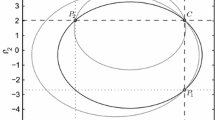Abstract
Employing a direct recursive algorithm in relation with analytical theories will yield a considerable saving in computer time, as opposed to simulating a point by point integration through repeated evaluations of the orbit theory. As a case in point, we shall compute the set of osculating orbiting elements corresponding to special events within the revolution of an artificial satellite.
Similar content being viewed by others
References
Aksnes, K.: 1970, ‘A Second-Order Artificial Satellite Theory Based on An Intermediate Orbit’,Astron. J. 75, 1066.
Brouwer, D.: 1959, ‘Solution of the Problem of Artificial Satellite Theory Without Drag’,Astron. J. 64, 378.
Henrici, P.: 1965,Elements of Numerical Analysis, John Wiley and Sons, Inc., New York, London, Sydney, p. 61.
Kozai, Y.: 1959, ‘The Motion of a Close Earth Satellite’,Astron. J. 64, 367.
Walter, H. G.: 1967, ‘Conversion of Osculating Orbital Elements into Mean Elements’,Astron. J. 72, 994.
Author information
Authors and Affiliations
Rights and permissions
About this article
Cite this article
Gordon, R.A. An analytical iterative algorithm for the prediction of special satellite orbit points with the Brouwer orbit theory. Celestial Mechanics 7, 280–290 (1973). https://doi.org/10.1007/BF01229952
Received:
Issue Date:
DOI: https://doi.org/10.1007/BF01229952




